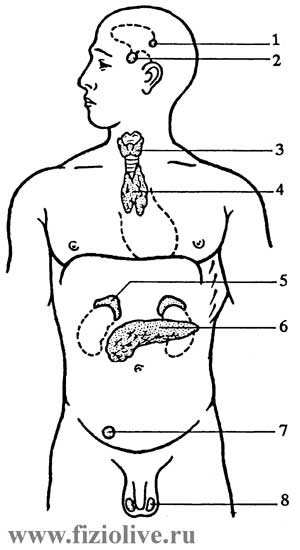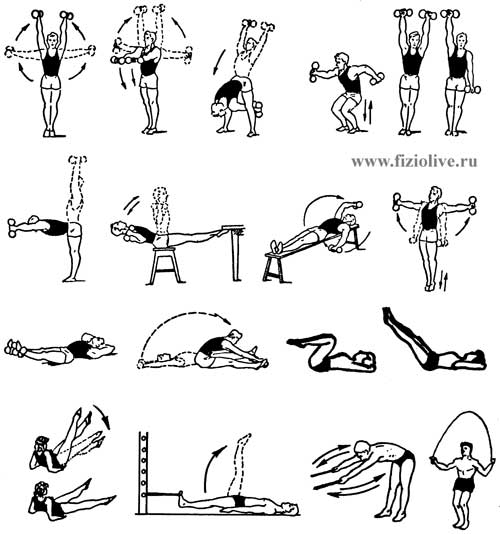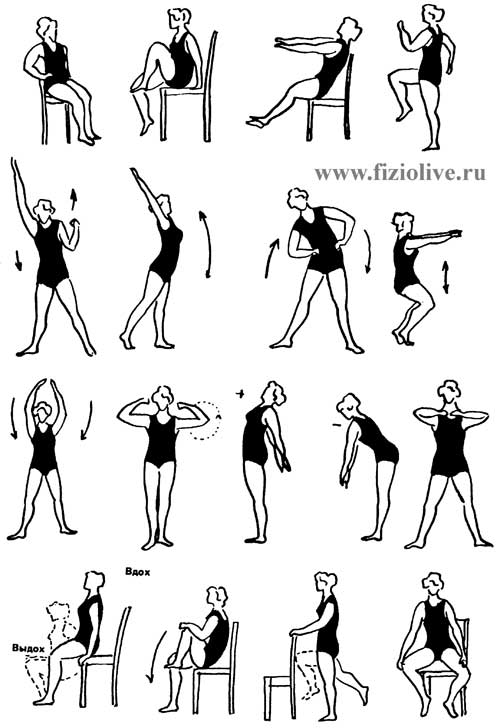
| HOME | MENU | DOCS | SEARCH |
Translations of articles in the English language
is in automatic mode, the original version
of the article in Russian - here
The content of the article "exercise therapy in diseases of the endocrine glands and disorders of metabolism":
*Initial position - I. p.
K internal secretion glands include the thyroid, parathyroid, pituitary gland, pineal body, thymus, adrenal and some other (see Fig. Glands of internal secretion). The function of the glands is to produce hormones that stimulate or, conversely, hindering the development and vital activity of separate organs and organisms as a whole. Hormones are usually produced in small quantities and with blood are transferred to the destination.
Endocrine glands (diagram)

1 - epiphysis, 2 - the pituitary gland; 3 - the thyroid gland; 4 - thymus gland; 5 - the adrenal gland; 6 - pancreas; 7 - ovary; 8 - testes
Endocrine glands are part of the system of neurohumoral regulation of body functions (see Fig. The major endocrine glands and their hormones are excreted). They produce the hormones play the role of chemical regulators of metabolic processes in tissues. The signal for the initiation of secretion of the hormone usually comes from sensory nerve endings - exteroanterocone or interoreceptors - and afferent neural pathways enters the CNS, in the hypothalamic region.
The major endocrine glands and their hormones are excreted
ACTH - adrenocorticotropic hormone; VIP - vasoactive intestinal peptide; LH - luteinizing hormone; MSH - melanocytestimulating hormone; STH - somatotropic (growth) hormone; TSH - thyroid stimulating hormone; FSH - follicle-stimulating hormone; HCM - human chorionic somatomammotropin
The normal flow of metabolic processes in the organism at rest and under changing environmental conditions is supported by a complete endocrine system.
Diseases of endocrine glands can occur with symptoms of excessive or insufficient function.
Physical exercises have a significant impact on metabolism. This explains the widespread use of exercise for disorders of the endocrine glands.
Obesity - increased body weight due to excessive deposition of adipose tissue. Distinguish exogenous-constitutional obesity due to imbalance between intake and energy expenditure in the presence of a constitutional predisposition; cerebral obesity, associated with disease of the brain (inflammation, trauma, tumors); endocrine obesity occurs when pathology endocrine system (pituitary disease, adrenal glands, thyroid gland, etc.).
There are three degrees of obesity: I degree - an excess of body weight by 30%; II degree - the excess of the body weight by 30-49%; III degree - an excess of body weight by 50% and higher.
When exogenous constitutional obesity recommended: diet (restriction of total calories, fluids, salt, smaller meals), 1-2 times a week fasting days, for example, 1.2 liters of kefir per day or 1.5-2 kg of apples); sauna (Banya) and the reception is warm the soul; physical activity (LH, dosed walking on rough terrain, swimming, skiing, games and other physical activities); vibration massage (followed by wiping the whole body of alcohol or brandy tincture); assignment of vitamin complexes and diuretics 1-2 times per week) with potassium supplements or dried apricots; vegetable laxatives.
In Fig. Approximate set of exercises for obesity shows a sample set of exercises with dumbbells, rubber shock absorbers, medicine balls and gymnastic wall. After school useful massage feet, back muscles, buttocks and legs.
Approximate set of exercises for obesity

Diabetes mellitus is a disease caused by an absolute or relative deficiency of insulin in the body and is characterized by gross violations of carbohydrate metabolism, with hyperglycemia and glucosuria ("diabetes urination"), as well as other metabolic disorders.
One of the etiological factors is hereditary predisposition, and obesity, atherosclerotic changes of the vessels of the pancreas, physical and mental trauma, infections, excessive consumption of carbohydrates.
Insufficiency of insulin in the body leads to disruption of carbohydrate, fat and protein metabolism.
There are three stages in the development of diabetes, potential diabetes, when there is only a predisposition to the disease; latent diabetes, which is detected by the sample on the tolerance to carbohydrates; explicit diabetes, when there are characteristic clinical and biochemical symptoms of the disease. Patients concerned about dry mouth, polyuria, weight loss, weakness, decreased disability, increased appetite, skin itch and itching in the perineum, pyoderma, fungal skin lesions, etc.
If you have diabetes, it is recommended massage with warm oil (fir, olive, eucalyptus, etc.), therapeutic exercises (see Fig. Approximate complex LH in diabetes), dosed walking, walking skiing, swimming, sauna (sauna), etc. the Main thing is to prevent fatigue.
Approximate complex LH in diabetes

Gout - a disease characterized by a violation of purine metabolism and is accompanied by accumulation of uric acid in the body. The characteristic manifestation of the disease - relapsing arthritis. Usually observed recurrent acute mono - or oligoarticular form of the joints of the lower extremities with frequent involvement of the 1st metatarsophalangeal joint (approximately 75% of patients), joints of the paw, ankle and knee joints.
Characterized by pain, movement in the joint becomes impossible, there is periarticular swelling, redness over the joint.
Gout is often combined with violations of other types of metabolism - obesity and diabetes. Gout in the area of attachment to bone of ligaments, joint capsules, tendons develop bony growths - osteophytes. There is often a deformity of the joints.
When gout is shown riding a bike, swimming, LH, diet (except meat, kidney, liver, beans, etc.), Banya (sauna), massage, drinking plenty of fluids, cross-country skiing, Spa treatments (swimming in sea, walking and running on the sand in the water, exercise on a Bicycle Ergometer, oxygen cocktails, etc.).
V.I. Dubrovsky,
Academician of the Russian Academy of Natural Sciences,
IANPO and the New York Academy of Sciences,
Doctor of Medical Sciences, Professor,
A.V. Dubrovskaya, pediatrician
It is available for the original version
of the article in Russian
<< Previous: Exercise therapy for injuries and diseases
We recommend that you look at the popular sections of the site myvaleology.com: MENU with a description of the sections | |||
| SOCIAL | DONATION | MY DIET | MY SPORT |

|
Release all4e8 |
||
Copyright © VZOJ 2023. All rights reserved. When reprinting or quoting myvaleology.com materials please put a link to the site myvaleology.com :
<a href="https://myvaleology.com">Healthy lifestyle</a>